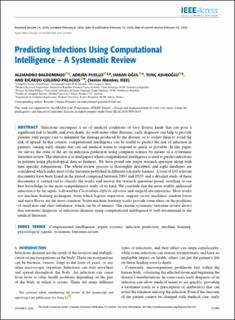| dc.contributor.author | Baldominos, Alejandro | |
| dc.contributor.author | Puello, Adrián | |
| dc.contributor.author | Ogul, Hasan | |
| dc.contributor.author | Aşuroğlu, Tunç | |
| dc.contributor.author | Colomo-Palacios, Ricardo | |
| dc.date.accessioned | 2021-01-29T14:30:40Z | |
| dc.date.available | 2021-01-29T14:30:40Z | |
| dc.date.created | 2020-02-20T11:30:13Z | |
| dc.date.issued | 2020 | |
| dc.identifier.citation | IEEE Access. 2020, 8, 31083-31102. | en_US |
| dc.identifier.issn | 2169-3536 | |
| dc.identifier.uri | https://hdl.handle.net/11250/2725419 | |
| dc.description.abstract | Infections encompass a set of medical conditions of very diverse kinds that can pose a significant risk to health, and even death. As with many other diseases, early diagnosis can help to provide patients with proper care to minimize the damage produced by the disease, or to isolate them to avoid the risk of spread. In this context, computational intelligence can be useful to predict the risk of infection in patients, raising early alarms that can aid medical teams to respond as quick as possible. In this paper, we survey the state of the art on infection prediction using computer science by means of a systematic literature review. The objective is to find papers where computational intelligence is used to predict infections in patients using physiological data as features. We have posed one major research question along with nine specific subquestions. The whole review process is thoroughly described, and eight databases are considered which index most of the literature published in different scholarly formats. A total of 101 relevant
documents have been found in the period comprised between 2003 and 2019, and a detailed study of these documents is carried out to classify the works and answer the research questions posed, resulting to our best knowledge in the most comprehensive study of its kind. We conclude that the most widely addressed infection is by far sepsis, followed by Clostridium difficile infection and surgical site infections. Most works use machine learning techniques, from which logistic regression, support vector machines, random forest and naive Bayes are the most common. Some machine learning works provide some ideas on the problems of small data and class imbalance, which can be of interest. The current systematic literature review shows that automatic diagnosis of infectious diseases using computational intelligence is well documented in the medical literature. | en_US |
| dc.language.iso | eng | en_US |
| dc.publisher | IEEE | en_US |
| dc.rights | Navngivelse 4.0 Internasjonal | * |
| dc.rights.uri | http://creativecommons.org/licenses/by/4.0/deed.no | * |
| dc.subject | computational intelligence | en_US |
| dc.subject | expert systems | en_US |
| dc.subject | infection prediction | en_US |
| dc.subject | machine learning | en_US |
| dc.subject | physiological signals | en_US |
| dc.subject | systematic literature review | en_US |
| dc.title | Predicting infections using computational intelligence – A systematic review | en_US |
| dc.type | Peer reviewed | en_US |
| dc.type | Journal article | en_US |
| dc.description.version | publishedVersion | en_US |
| dc.subject.nsi | VDP::Teknologi: 500::Informasjons- og kommunikasjonsteknologi: 550 | en_US |
| dc.source.pagenumber | 31083-31102 | en_US |
| dc.source.volume | 8 | en_US |
| dc.source.journal | IEEE Access | en_US |
| dc.identifier.doi | 10.1109/ACCESS.2020.2973006 | |
| dc.identifier.cristin | 1796045 | |
| cristin.ispublished | true | |
| cristin.fulltext | original | |
| cristin.qualitycode | 1 | |

